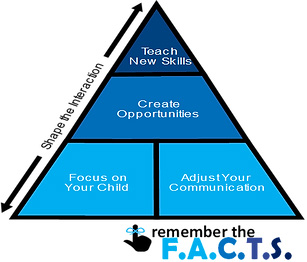As an adult sometimes it can be a challenge to remember how to play! After all, it has been a long time since we’ve been asked to sit on the floor and be silly. So, what are the two most important things to remember when trying to engage with your child during play?
Project ImPACT is a parent mediated training program that focuses on teaching parents to increase their child’s social communication skills by using a few simple techniques. At KMBC inc., our clinicians use these techniques to increase the length of time a child will engage with us, their eye contact, joint attention and communication whether it is by verbally telling us about what they’re doing or non-verbally by gesturing and guiding us to join in.
The curriculum uses a pyramid visual and acronym called the F.A.C.T.S pyramid to help a parent visualize what joining in play might look like. In this blog we will be focusing on the first two strategies at the base of the pyramid:
1) Focus on your child
2) Adjust your communication

Focus on your child:
The focus on your child strategy encourages parents to follow their child’s lead. This means joining in their play as opposed to directing it. Some of you might be thinking – “EASY! I already do this but my child still does not engage with me – why is this?”. One thing to keep in mind is how often are you asking questions during play. For example: while playing with blocks you ask “where’s the blue block?” or with animals “The cow says moo – show me the cow”. Questions and demands like these imply that you are in fact leading the play and this can be seen by your child as an instruction as opposed to just a fun activity and they may want to move away from you or not engage with you. Instead of asking a question try making a comment about what they’re dong. For example: “wow look at that big blue tower!” or “The cow says moo!”.
When joining in your child’s play the best place for you to sit is face to face with them so they can see your engagement. You might also try using some imitation. For example if they do something silly or make a sound or gesture you can try doing the same. This shows them you’re interested in what they’re doing and they might think it’s quite fun which could lead to some positive engagement opportunities. Don’t be afraid to imitate movements or gestures you may deem as silly or weird. For example, if they begin rolling on the floor try to roll with them or if spinning in circles give it a go! Later when your child is engaged there will be plenty of opportunities to model new and fun ways of playing that might be more meaningful and appropriate. But remember we don’t want to imitate inappropriate behaviours as this could reinforce them. For example, if your child throws a toy or gets upset.
Adjust your communication:
Now that you know how to focus on your child and join in their play it’s time to work on adjusting your communication. What does this look like? The things to try here are:
- Increase your animation – use exciting facial expressions and play with the volume of your voice. You can even try using anticipatory phrases such as “ready….set…..go!”
- Comment on what your child is doing using language that is at or slightly above where they are. For example if your child is gesturing, comment by using gestures plus single words. If your child is using single words, comment by using 1-2 words.
- Emphasize your words and gestures. For example when commenting on the tower you can say “Wow BIG tower” while showing how tall it is with your hands.
- Try picking a few key words to repeat during your play session so your child hears these multiple times. This increases the likelihood they may try saying the same word or imitating you.
- If at any time your child provides you with a communicative attempt (gesture, word, sentence) expand on what they’ve said by providing a comment that is at or slightly above where they are with their language skills.
We can’t wait to hear how play time is going at home! Stay tuned to our blog for more tips and tricks to increase engagement with your child during play and daily routines.
For more information about our services visit: www.kerrymaisels.com
